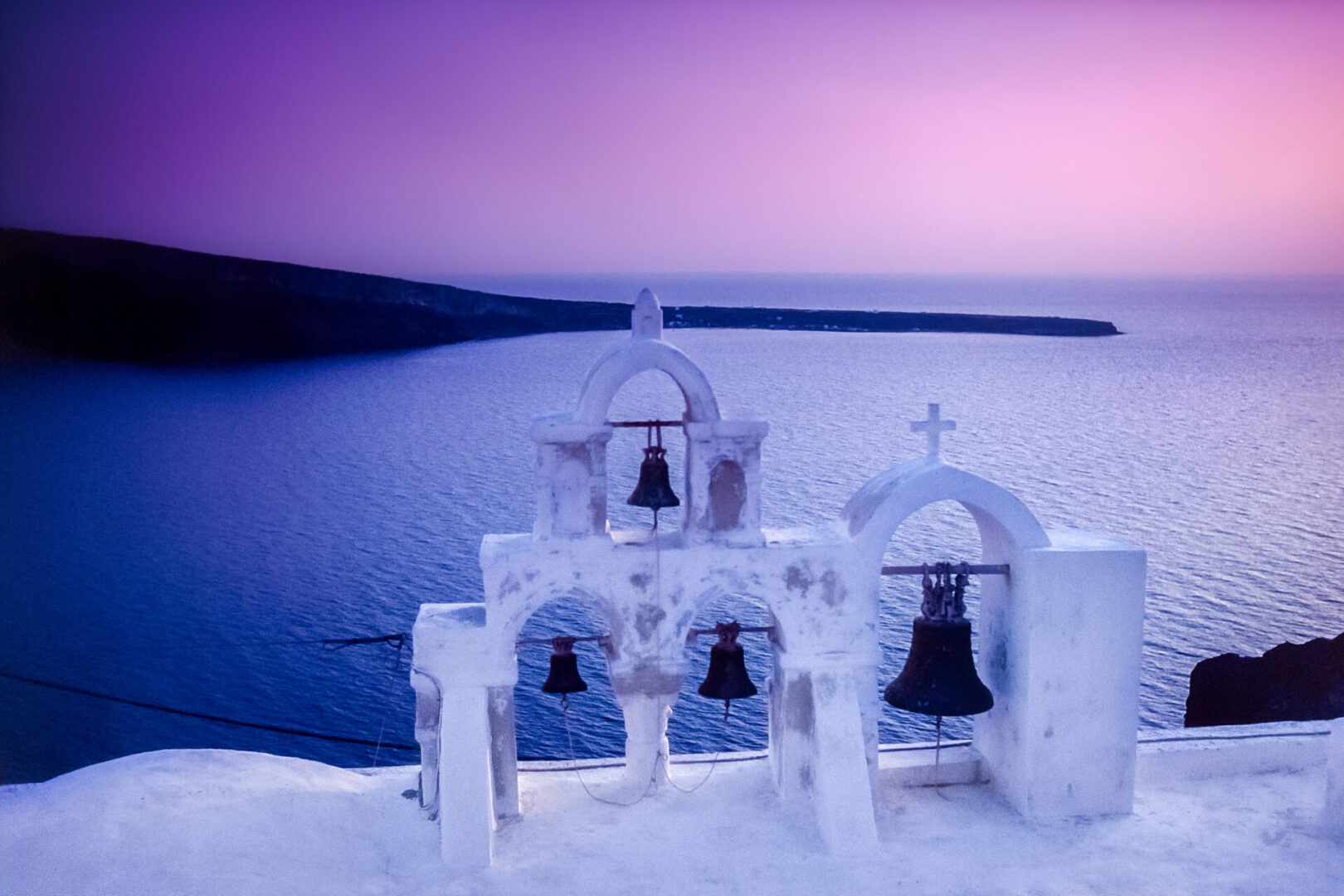
Landmarks in Greece often evoke ancient times shrouded in mists, mysteries, and mythology.
The most famous landmarks do indeed date from ancient Greece and connect Greek gods, heroic legends, and actual historical people.
However, Greece and its famous landmarks span the ages, from far-distant antiquity to medieval epochs to the present-day modern nation.
Greece offers so much to explore, experience, and inspire your memorable and meaningful travel.
Throughout all 14 Greek regions, this diverse country delivers rich history, cultural traditions, and natural beauty alongside ancient ruins.
Let’s discover some of the best and most beautiful landmarks to visit both in mainland Greece and the Greek Islands.
Additionally, we’ll uncover some “little legends” of lesser-known myths and stories.
Also, find tips to visit these famous landmarks in popular places, as well as more remote locations, in all 14 Greek regions.
Ready? Let’s go!
Table of contents
- Famous Landmarks in Greece: Attica
- Famous Landmarks in Greece: Central Greece
- Famous Landmarks in Greece: Central Macedonia
- Famous Landmarks in Greece: Crete
- Famous Landmarks in Greece: Eastern Macedonia and Thrace
- Famous Landmarks in Greece: Epirus
- Famous Landmarks in Greece: Ionian Islands
- Famous Landmarks in Greece: North Aegean Sea
- Famous Landmarks in Greece: Peloponnese
- Famous Landmarks in Greece: South Aegean Sea
- Famous Landmarks in Greece: Thessaly
- Famous Landmarks in Greece: Western Greece
- Famous Landmarks in Greece: Western Macedonia
- Famous Landmarks in Greece: Mount Athos
- Famous Landmarks in Greece: In Conclusion
- Map
- Check Out More Recommendations
- FAQs
Famous Landmarks in Greece: Attica
Acropolis of Athens
Greece’s crowning glory and incomparable UNESCO World Heritage Site, the Acropolis of Athens reigns in majesty above the sprawling modern city.
This peerless landmark in its present layout comes courtesy of Pericles, the prominent civic and military leader in the 5th century BC Golden Age of Athens.
The Parthenon
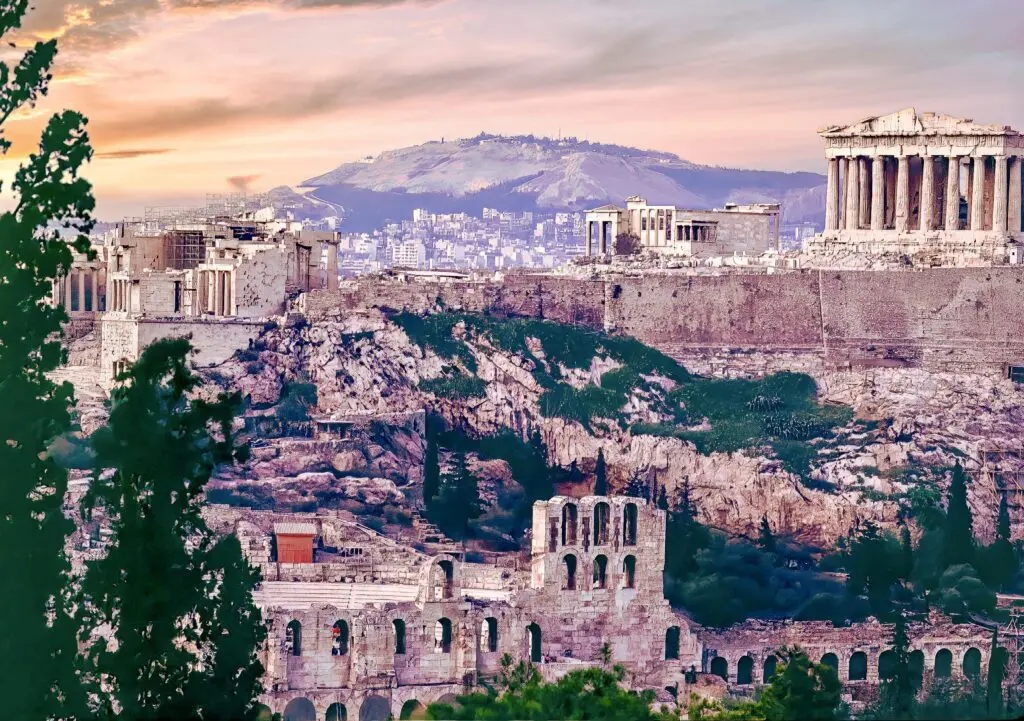
One monument on the Athenian Acropolis achieves ultimate status, an icon instantly recognized around the world: the Parthenon.
With perfect symmetry and powerful simplicity, the Parthenon expresses high ideals, evokes endless admiration, and inspires enduring awe.
Within the Parthenon, the renowned Phidias sculpted a monumental statue of the goddess Athena in bronze.
Phidias created her likeness to herald the wealth, strength, and authority of Athens.
Extant coins and literature document and describe the size, design, and symbolism in detail.
In the 2nd century AD, in his Description of Greece, geographer and travel writer Pausanias observes Athena’s bronze helmet and spear gleaming afar on Cape Sounio.
In the 5th century AD, the great bronze sculpture came to Constantinople for its protection and, alas, ultimate loss.
The Plateau
The Propylaea forms the ceremonial western entryway to the ancient citadel. To this day, the grand Propylaea remains the primary entrance and exit, up and down steep marble steps.
Other temples, sanctuaries, altars, and statues grace the plateau. Two notable landmarks are the small but striking Temple of Athena Nike and the unique Erechtheion.
Located to the right of the Propylaea, the Temple of Athena Nike celebrates Victory. The architect Kallikrates designed the Ionic temple.
The workshop of sculptor Agorakritos created statues and friezes, including Nike the Sandalbinder. Wings closed, the Nike lifts her foot to slip off her sandal before entering the temple.
The Acropolis Museum displays the Sandalbinder in its priceless collection of Acropolis art and artifacts.
Little Legend of the Acropolis of Athens
Of all the historic landmarks on the Acropolis of Athens, one special landmark is the personal favorite of this writer and this photographer: the Erechtheion.
The Erechtheion is the Temple of Athena Polias, Protector of the City, with Ionic columns and intricate detailing.
What chiefly sets the Erechtheion apart are two uncommon aspects:
In the first place, the Erechtheion’s asymmetrical design is unlike other classical architecture; for example, the Parthenon’s perfect symmetrical balance.
In the second place, its Southern Porch incorporates female figures instead of columns to support the roof.
Six harmonious marble maidens hold aloft the Southern Porch of the Caryatids.
Today, because of Athens’ pollution, these six sisters are exact reproductions of the original statues.
Five original Caryatids are in the Acropolis Museum; the sixth original is in the British Museum of London, England.
PS: The Caryatides’ birthplace is a true hidden gem, a little-known Greek landmark off the beaten path.
Tips to Visit the Acropolis of Athens
Expert insight enhances everything there is to see and understand about the Acropolis of Athens, the first and foremost of Greece’s most important archaeological sites.
So the best way to elevate your experience on the Acropolis of Athens is with a professional local tour guide.
Discover the best tour options.
The best time to visit typically is either early morning or late afternoon.
The Acropolis of Athens is open daily year-round, from sunrise to sunset, with the raising and lowering of the Greek flag.
Weather permitting, of course. During the extreme heat wave of Summer 2023, for instance, the Acropolis closed in the hottest hours.
Whenever you visit, the best things to bring are bottled water, a hat, sunglasses, and sunscreen. Because the ancient citadel has no services and little shade.
Wear comfortable and ideally sturdy shoes to climb up and down the Acropolis’ steps and on its uneven plateau.
Additionally, an elevator on the northern side provides access for mobility-impaired visitors and parents with two or more infants.
The Greek government’s official agency Hellenic Heritage has information on Acropolis elevator access.
Notes on Entry to the Acropolis 2024
From early spring through late fall, the line to enter the Acropolis is always long, very long. For everyone, yes, even those with skip-the-line tickets.
In order to provide greater protection to this iconic monument and a better experience for tourists, the government announced tentative entry limits, which started in September 2023.
From April 1, 2024, the entry limits should be permanent, allowing a maximum of 20,000 visitors daily in timed entries per hour.
Ancient Agora of Athens
Dating from the 6th century BC, the Ancient Agora of Athens was an essential hub of classical urban life.
From libraries to law courts, artists to assemblies, socializing to shopping, the Ancient Agora of Athens encompasses a broad spectrum of stoas, temples, monuments, and even a mint for coinage.
In the 1st century AD, the Apostle Paul preached daily in the Agora, the synagogue, and the Aeropagus. Atop the rocky outcrop of the Aeropagus, a bronze plaque memorializes his powerful sermon in Acts 17:16-34.
In the summer months, the Ancient Agora of Athens is a great place to escape from the hot sun. A short walk along paths lined with trees, shrubs, and lawns is a refreshing respite.
Fifth century BC Temple of Hephaestus stands among the Ancient Agora’s most impressive landmarks.
Well preserved and almost wholly intact, the Hephaisteion helps to imagine the Parthenon in its original state.
Syntagma Square and Tomb of the Unknown Soldier
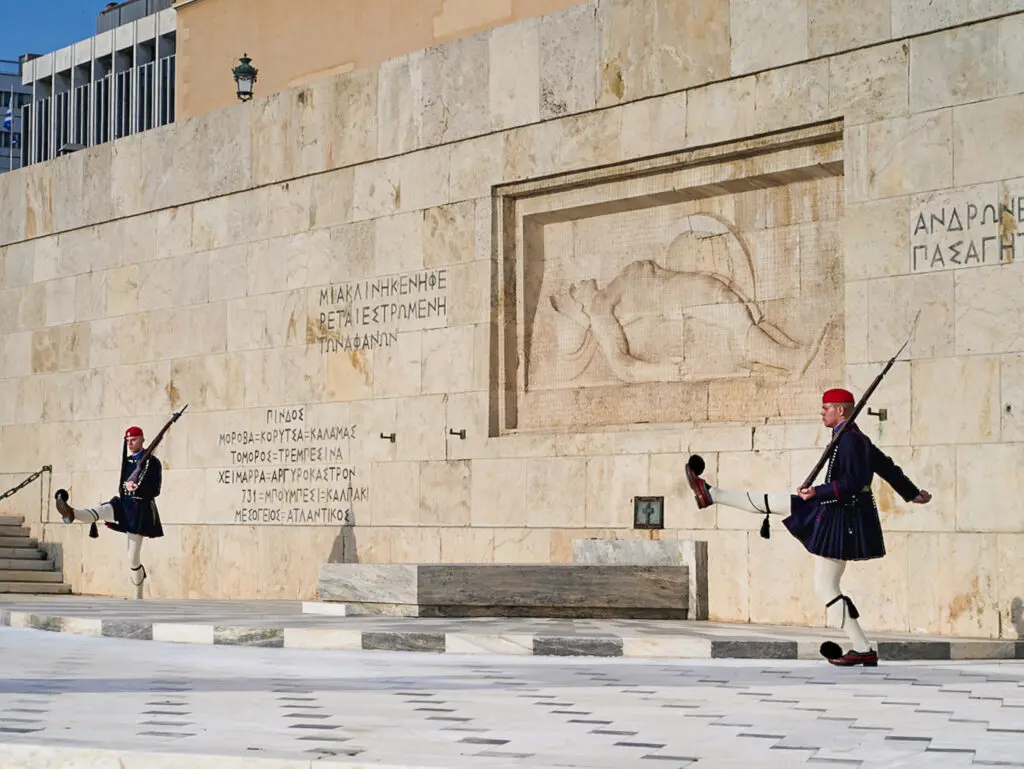
Athens’ heart and city center is Syntagma Square, a vast plateia in front of the Old Royal Palace, housing the Greek Parliament since 1934.
Amalia Avenue, Otto Street, and King George I Street flank the square and lead to popular tourist attractions in nearby neighborhoods such as Plaka, Monastiraki, and Psiri.
Stadiou Street, Athens’s top shopping street, links Syntagma and Omonia Squares.
Constitution Square is a busy transportation hub with Metro and Tram stations, bus stops, taxis, non-stop traffic, and pedestrians galore.
Broad marble steps lead to the Old Royal Palace, a neoclassical historical landmark completed in 1843 and currently in use as the Parliament Building; and to the Tomb of the Unknown Soldier, dedicated in 1932.
On the hour, the elite Evzones perform a slow and serious choreographed ceremony at the Tomb of the Unknown Soldier and Eternal Flame.
The Presidential Guard selects its members from Hellenic Army standouts. Evzones are famed for their height, discipline, and ceremonial uniform.
Temple of Olympian Zeus
Not to be confused with Olympian Land in Western Greece, the Temple of Olympian Zeus dominates a vast archaeological site in Athens.
This largest temple in the ancient world took centuries to complete. Construction began more than 500 years before Christ. Under Roman Emperor Hadrian, construction eventually finished in the 2nd century AD.
On one side, the gate to the Temple of Olympian Zeus proclaimed, “This is the Athens of Theseus, the old city.”
The opposite side of the gate asserted, “This is the city of Hadrian, not of Theseus.
Panathenaic Stadium
The Modern Olympics originated in Greece, not only in Ancient Olympia but also here in Athens at the Panathenaic Stadium.
The site of a racecourse since the 6th century BC, the Panathenaic Stadium originally hosted the Panathenaic Games every four years from the 4th century BC until the 3rd century AD.
Abandoned for centuries, the ruined stadium was restored and refurbished in the 19th century.
In 1896, the world’s only all-marble stadium hosted the first international Modern Olympic Games, the Games of the 1st Olympiad; as well as the 2004 Summer Olympics, the Games of the 28th Olympiad.
Additionally, before every Olympics, the Panathenaic Stadium hosts the formal ceremony wherein Greece hands over the Olympic flame, lit in Ancient Olympia, to the host city.
Lastly, the Panathenaic Stadium is the finish line for the Athens Marathon.
This classic route retraces the legendary run of Phiedippides in 490 BC, bearing the message of victory from the Battle of Marathon to Athens, 26.2 miles (42 km) away.
Tips to Visit the Panathenaic Stadium
The Panathenaic Stadium opens to visitors year-round.
The best time to visit in the summer months is early morning and late afternoon.
Because the stadium is entirely open to the elements, make sure to bring water, a hat, sunglasses, and sunscreen in the summer months. In cooler months, wear layered warm clothing.
And oh yes, do bring sneakers! Because the entrance fee includes access to run the track.
After that triumphant lap around the track, commemorate the moment with your photo atop the medal podium. In the first-place gold medal position, of course.
For another fabulous photo, climb to the upper tier of Stand 21.
This perspective shows the Acropolis, Filopappou Hill, the Temple of Olympian Zeus, Zappeion Megaron in the National Gardens, and Mount Lycabettus.
Mount Lycabettus
The highest point in Athens is Mount Lycabettus, rising 908 feet (277 m) in the city center.
From the top, sweeping views encompass the entire capital city. From ancient history to modern metropolis, the Athenian sights dazzle and delight.
Besides the panorama, there is a cafe-restaurant and two churches: 19th century Agios Georgios on the plateau; and Agios Isidoros, circa 15th to 16th century, on the western slope.
The 1960s Lycabettus ampitheatre awaits restoration and is thus closed at this time of publication.
To ascend or descend Mount Lycabettus, either drive or take a taxi up the Lycabettus ring road. Or climb a long, steep hike up zig-zagging stairs.
The fun thing to do is ride the Lycabettus Funicular, a three-minute tunnel ride up and down the hill between Konolonaki Station and Agios Georgios.
Temple of Poseidon
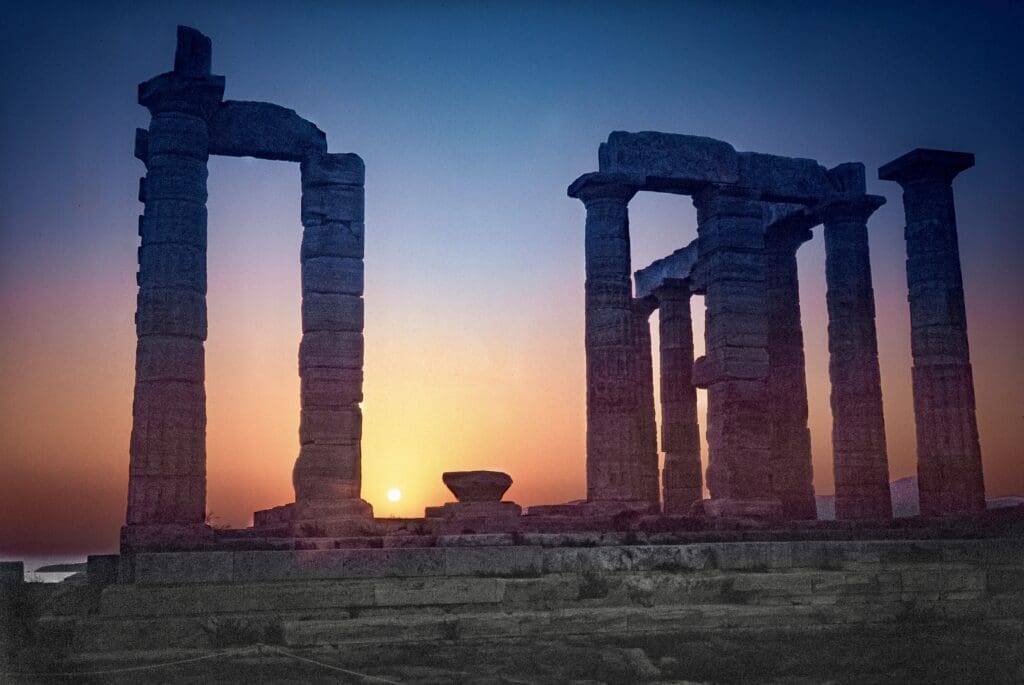
The magnificent Temple of Poseidon commands the Cape of Sounio on mainland Attica’s southern coast. Protected since 1974, Sounio is the smallest of Greek National Parks.
The Saronic Gulf Islands set the stage for this spectacular site of two Greek gods.
Dedicated to the mythological sea god, the ancient Temple of Poseidon dates from the 5th century BC. Of the original 34 Doric columns, 13 still stand in stark splendor.
Nearby on a lower level, the Temple of Athena Souniados leaves behind only a few ancient stones.
Constructed in the same 5th century BC timeframe as the Temple of Poseidon, Athena’s temple was less important. Because the entire structure was later disassembled in order to build other structures in Athens.
Not only is the sanctuary a historical landmark, but it also serves as a nautical landmark.
From the sea, ancient sailors saw these mighty marble pillars and knew they were nearing Athens. In the same way, modern-day cruisers thrill at the sublime sight.
On land, the Temple of Poseidon is a perfect place to watch the sunset into the Aegean Sea.
Tips to Visit the Temple of Poseidon
For a standard starting point, the driving distance between Athens International Airport “Eleftherios Venizelos” (ATH) and Cape Sounio is about 28 miles (45 km).
The route takes roughly 1.5 to 2 hours, depending on traffic and weather conditions.
If you choose to drive, be aware; because the final stretch of road can be challenging, especially after dark.
Public KTEL buses, the OASA subway, and long-distance taxis are further options.
Or, for comfort, convenience, and expert insight, consider a guided sunset tour with round-trip transportation between Athens and Cape Sounion.
Discover the best tour options.
Famous Landmarks in Greece: Central Greece
Sanctuary of Delphi
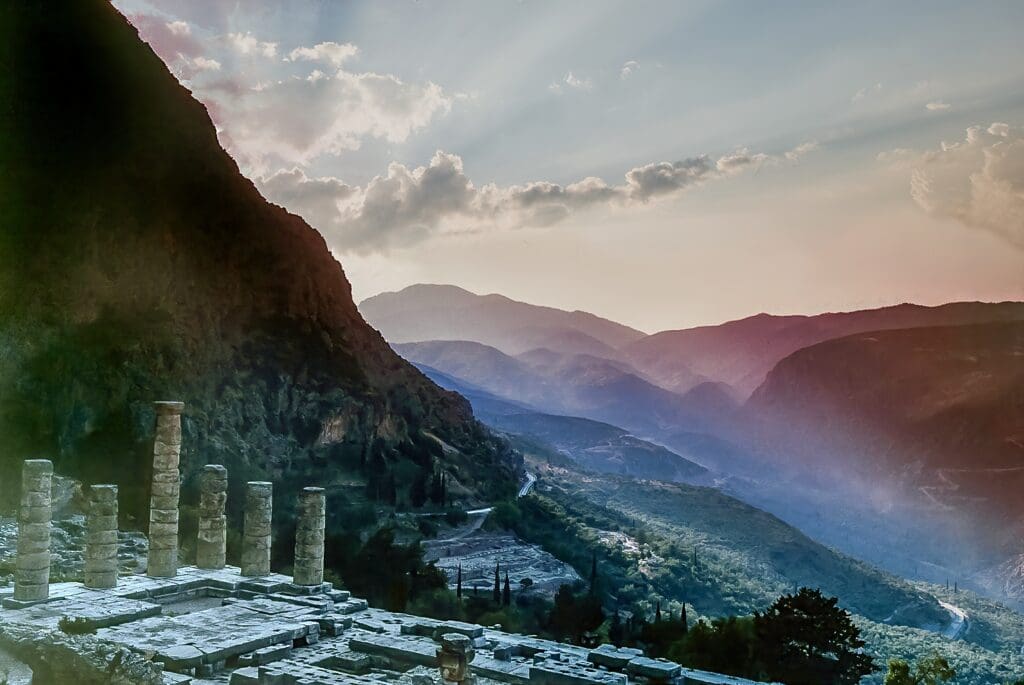
Mount Parnassus in Central Greece holds an archaeological site of immense importance and wealth: the Sanctuary of Delphi.
For millenia, visitors traveled from afar to consult Pythia, the mysterious Oracle of Delphi by whom Apollo spoke.
Today, visitors travel from afar to explore this UNESCO World Heritage Site, among Greece’s most important landmarks.
The god Apollo ruled supreme at the Sanctuary of Delphi. And the Temple of Apollo was his seat of supremacy.
Inside the Temple of Apollo, the high priestess Pythia sat on a tripod seat and proclaimed Apollo’s mystical Delphic Oracles.
The massive Apollon dates from the 4th century BC built over ancient ruins of earlier temples.
The site encompasses plentiful altars, stoas, treasuries, stoas, and temples. A gymnasium, hippodrome, stadium, and theatre attest to the festivals held throughout the ancient calendar.
The elegant Tholos of Athena Pronoia is perhaps the most photographed monument in Delphi. This circular temple to the goddess Athena of Providence has three Ionic columns on its round edge.
Little Legend of Delphi
The ancient Greeks believed the Sanctuary of Delphi to be the center of the earth. Literally.
Legend tells us that Zeus sent two eagles in flight from opposite ends of the earth; their paths crossed here, between the Phaidriades peaks.
Inside the Temple of Apollo, the Omphalos monument marked the eagles’ intersection and the earth’s “navel.”
Tips to Visit Delphi
The driving distance between Athens International Airport “Eleftherios Venizelos” (ATH) and Delphi is approximately 124 miles (200 km).
KTEL public transportation buses and long-distance taxis are options without a car.
Transportation aside, the best way to experience this far-reaching and far-flung archeological site is with a professional local guide.
Check the best tour options.
Modern Delphi and Arachova are two nearby towns, convenient locations for meals, coffee breaks, and hotels.
This author chose Arachova, about 6.5 miles (10.6 km) away from the Sanctuary of Delphi.
Although especially popular in winter for Athens’ “ski and be seen” crowd, Arachova is postcard pretty all year.
Arachova’s historic center is a great place to stay. Quaint shops, restaurants, and cafes are within walking distance along its cobblestone streets.
Just off the main plateia, Koukoura Square, the Ampolis Guest House welcomes you with charm and taste. In addition to a fireplace in each suite, heating and air conditioning ensure all-season comfort.
If you prefer, of course, the area overall has ski resorts, villas, and chalets.
Check the best rates for your stay.
Famous Landmarks in Greece: Central Macedonia
Thessaloniki
The second-largest city in Greece, Thessaloniki bridges the past and present.
As Central Macedonia’s regional capital city, and the nation’s cultural capital, Thessaloniki (also known as Saloniki, Thessalonica, and Salonica) is an urban hub for the arts, fashion, finance, technology, and gastronomy innovations.
Furthermore, Thessaloniki is a top tourist destination. CNN names Thessaloniki among the 23 Best Destinations 2023.
White Tower of Thessaloniki
Few sites impart the city’s influential status better than its once fearsome and infamous landmark: Lefkos Pyrgos, the White Tower of Thessaloniki.
Formerly a defensive fortress and a notorious prison, the centuries-old tower remains an imposing fixture on the waterfront.
Its severe stone exterior is unmistakable, at 112 feet (34 m) in height, topped by a turret another 20 feet (6 m) high.
Tradition maintains that the Venetians built this current tower circa 15th or 16th century. Meanwhile, scholars ascribe its construction to the Ottomans and debate its exact date of construction.
Little Legend of the White Tower of Thessaloniki
The White Tower of Thessaloniki has different names: Lion Tower, Tower of Janissaries, Tower of Blood, Red Tower, and the Bastille of Thessaloniki.
The origin of the White Tower name comes from the official White Tower source:
In 1883, Sultan Abdul Hamid II ordered the tower to be painted white to indicate that “winds of reform were blowing in the Ottoman Empire”.
In short, a convicted prisoner named Nathan Guiledi volunteered to paint the tower white. Offer accepted and the work completed, Guiledi thus gained his freedom.
Tips to Visit the White Tower of Thessaloniki
Before the 20th century, fortifications fully encircled the White Tower of Thessaloniki. In 1911, the defensive walls came down.
Now that means visitors today can walk right up to the Tower, wander its circumference, and of course, take photographs.
The Museum of Byzantine Culture oversees the Museum of the White Tower.
Mount Olympus
The mythical home of Greek gods, Mount Olympus is Greece’s highest mountain and tallest natural landmark.
Piercing the sky above the Macedonia and Thessaly regions, the highest point is Mytikas Peak at 9,572 feet (2,917 m) above sea level.
In 1938, Greece created its first National Park across 92 square miles (238 km2) on this most legendary mountain.
In 1981, Mount Olympus National Park became a UNESCO World Biosphere Reserve.
The reserve protects forests, gorges, ravines, rivers, waterfalls, and over 1,700 species of flora and fauna. Several species are rare and endangered, such as the bearded vulture and golden eagle.
The main attraction is hiking and climbing Mount Olympus. Trails range from gentle mountain paths to serious summit ascents.
Little Legend of Mount Olympus
Greek mythology and Homeric traditions describe Olympus as the ethereal realm of the Panhellenic gods.
Twelve Olympian gods resided in these celestial heights, inhabiting palaces and meeting together at the Pantheon of Mount Mytikas.
Muses and other immortals lived in its foothills. In due time, real-life Iron Age mortals followed and built their villages here.
Tips to Visit Mount Olympus
Nestled on Olympus’ northern slope under Mytikas’ peak, Litochoro is the main town for visitors, walkers, mountain bikers, canyoners, climbers, and mountaineers.
Litochoro is the home base for the main hiking associations because the most popular climbing route starts here to the Enipeas Gorge.
Additionally, Litochoro hosts the official Olympus National Park Information Center, an invaluable information resource.
The town itself is charming and historic, with a well-developed tourism infrastructure.
Accommodations run the gamut from traditional guest houses and pensions to upscale boutique properties like Robolo Boutique Hotel.
Bonus, Litochoro overlooks the Thermaic Gulf. Yes, the Aegean Sea is only a few kilometers and a short drive away from Mount Olympus.
Akrotiri Olympus Luxury Suites, a posh hotel in Gritsa Litochorou, boasts its own private beach on the Aegean Sea.
Inside Mount Olympus National Park, refuges accommodate overnight stays. Most are organized refuges; several have restaurants. Six refuges are emergency shelters.
A few refuges remain open year-round; others open seasonally from May or June through October.
The Olympus National Park has refuge details, reservations, and contact information.
If you desire a delightful day in nature, then a slow-paced guided excursion is a great choice here.
When you want serious hiking or high-adrenaline outdoor adventures, then a certified mountaineering guide is necessary.
Explore the best tour and adventure options.
Famous Landmarks in Greece: Crete
Among thousands of Greek Islands, Crete is the largest island and the most populated island. Numerous small islands and islets throng the coast, completing the Region of Crete.
Furthermore, its land mass, shaped rather like a long spearhead, demarcates the South Aegean Sea from the Libyan Sea.
Mountain ranges, rivers, lakes, and coastlines define the dramatic terrain.
Crete is blessed not only with great natural beauty but also agricultural bounty and bustling urbanity in its cities, towns, and villages.
Minoan Palace of Knossos
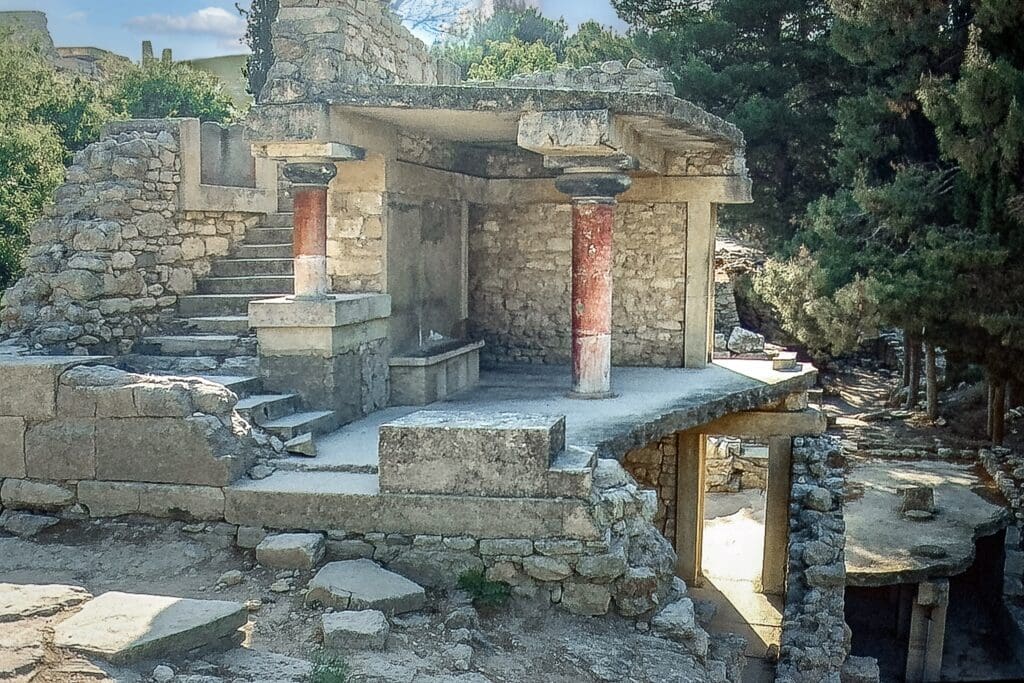
Just beyond the capital city, Heraklion, lies Crete’s top tourist attractions and most famous historical landmark: the Minoan Palace of Knossos.
This royal palace and four other archaeological sites display the arts and sciences of a highly advanced prehistoric culture: the Minoans.
Altogether, Crete’s Minoan Palatial Centres make the UNESCO World Heritage Centre Tentative List.
The Bronze Age Minoan civilization dates from the 28th century BC to the 15th century BC. In sum, Minoans pre-date the Myceneans.
Firstly, local Greek amateur archaeologist Minos Kalokairinos discovered the site in 1878.
Secondly, from 1900 to 1931, British archaeologist Sir Arthur Evans directed excavations of the Knossos labyrinth, ancient city, cemeteries, and more.
Evans determined the singular aspects of the ancient site, art, and artifacts. Additionally, he deciphered Minoan Scripts Linear A and Linear B.
Moreover, Evans reconstructed and repainted certain areas; for instance, the Northern Entrance, Throne Room, and Royal Villa.
With the result that the Minoan Palace of Knossos is surely Greece’s most colorful historic landmark.
Little Legend of Knossos Palace
In his epic Metamorphoses, the poet Ovid narrates the cautionary tale of Daedalus and his son Icarus.
Architect and inventor Daedalus designed the labyrinth at Knossos. But he yearned to elude King Minos, escape the ancient city, and return home to his native land.
So, clever Daedalus crafted great wings of feathers held together by beeswax. Accordingly, the pair escaped.
Although his father had instructed Icarus to fly neither too high nor too low, the lad couldn’t withhold his exuberance. Higher and higher, he flew.
Until, alas, young Icarus flew too close to the sun. The scorching heat melted the wax.
With wings disintegrated, Icarus plunged to his death in the dark sea below.
Tips to Visit Knossos Palace
With the Minoan Palace of Knossos such a popular destination, the best time to visit in high season is either early morning or late afternoon. If the latter, then arrive 2 hours before closing to allow sufficient time to explore.
The best things to bring are bottled water, a hat, sunglasses, and sunscreen.
Also, do wear sturdy shoes. Like many ancient sites, some sections are covered, and some paths are paved; otherwise, Knossos Palace is open to the elements.
The official government agency Hellenic Heritage provides opening hours, accessibility access, and other information.
On the whole, a guided tour deepens appreciation of the advanced civilization and refined culture in effect on Crete and elsewhere.
Check out the best tour options.
Samaria Gorge
Crete’s mountain ranges and gorges protect forests, flora, and fauna, including the vulnerable kri-kri Cretan goat.
The world-famous Gorge of Samaria National Park is between the White Mountains and Mount Volakias, on the southwest coast near Chania.
Part of the EU Natura 2000 Network, Samaria Gorge is a UNESCO World Biosphere Reserve.
Europe’s longest gorge is the Samaria Gorge, extending about 8 miles (13 km) from north to south. With an additional 2 miles (3 km) stretch to the village of Agia Roumeli to return via ferry boat, the total distance is 10 miles (16 km).
The Gates are the most distinctive part of the trek. Here, the width narrows to about 13 feet (3 m) wide, and steep walls reach 980 feet (298 m) high.
Tips to Visit Samaria Gorge
In season, that is, May 1 to October 31, Samaria Gorge National Park opens daily from either 6 am or 7 am until 4 pm, weather permitting.
Overall, Samaria Gorge is a challenging trek. The trail is a long, steep descent; with rocky outcrops and several river crossings either by small wooden bridges or stepping stones.
It’s a full-day hike, so the best time to start is early morning. Then, to return from Agia Roumelia to Chania requires a boat passage.
The Gorge has two access points: north at Xyloskalo near Omalos Plateau and south near the village of Aigia Roumeli.
Xyloskalo is the highest point at 4,025 feet (1,227 m) and the logical entrance. Because the trail descends from Xyloskalo to the lowest point Agia Roumeli, on the sea.
The best things to bring are water, layered clothing, a hat, sunglasses, sunscreen; and proper hiking shoes or hiking boots.
Natural springs flow within the Gorge to re-fill bottles or canteens with fresh water.
Also, plan to put food and any essentials in your daypack. Because there are no shops or services inside Samaria National Park.
For public transportation, KTEL buses run to Omalos.
Agia Roumeli has no access except by sea. Anendyk Seaways operates the Aiga Roumelia ferry service.
For ease and convenience of round-trip ground transportation and ferry ticket, as well as the benefit of a professional local trekker, consider a guided hike.
See the best options for hikes and outdoor adventures.
Spinalonga Island
Nearby Elounda’s chic resorts on Crete’s eastern coast, Spinalonga Island makes the UNESCO World Heritage Tentative List.
From the late 1500s to 1903, a medieval fortress protected this strategic location for the Venetians and then the Ottomans. The latter also built homes and businesses here.
Lastly, from 1904 to 1957, Spinalonga served as one of Europe’s last leper colonies.
This small island may seem an unlikely tourist attraction in light of its sorrowful history and melancholy mood.
But in this case, its one-of-a-kind setting and story reveal the resilience, fortitude, and hope of the human spirit.
After entering through Dante’s Gate, the best place to begin is the interpretative museum. Then wander the archeological site at leisure.
Some buildings are restored; others remain ruined and abandoned throughout the archeological site.
Climb up to the old citadel for a panoramic tableau and respectful reflections.
Because Spinalonga Island is, as UNESCO describes, “imbued with the aura of the people who lived here.”
Tips to Visit Spinalonga Island
In season, April to October, boats depart daily for Spinalonga Island from Plaka village (less than 10 minutes one-way ride), Elounda (about 30 minutes), and Agios Nikolaos (approximately 45 minutes).
Before or afterward, read The Island, an award-winning historical novel by British author Victoria Hislop.
Mega Channel Greece produced the international bestseller book as a 2010 Greek television series.
Famous Landmarks in Greece: Eastern Macedonia and Thrace
Greece’s remote Region of Eastern Macedonia and Thrace (EMT) shares borders with Turkey and Bulgaria.
Agriculture and viniculture have always been crucial to the economy here. Tsipouro brandy is a Greek Protected Designation of Origin (PDO) spirit. Sericulture (silk) also supports EMT’s ancient traditions.
The pristine natural environment, together with traditional culture, draws visitors to this area of the Balkans.
Dadia-Lefkimi-Soufli National Park
Part of the EU Natura 2000 Network, the Dadia-Lefkimi-Soufli Forest National Park is on the UNESCO World Heritage Centre Tentative Lists.
Rich biological diversity fills the park’s pine and oak forests with hundreds of species of plants, butterflies, reptiles, amphibians, and mammals.
Moreover, Dadia-Lefkimi-Soufli Forest National Park has over 200 species of birds. Its nickname is “the Land of the Birds of Prey.” There’s even a Birds of Prey Observatory.
So binoculars for bird watching are among the best things to bring along.
On the park’s outer edge is a geological landmark distinct in Europe: the Lefkimi-Fylkato Fossilized Forest.
Greece’s oldest petrified forest features fossils in their original natural environment. Scientists attribute the oldest fossils to volcanic eruptions anywhere from 25 million to 40 million years ago.
Tips to Visit Dadia-Lefkimi-Soufli National Park
Flights between Athens International Airport “Eleftherios Venizelos” (ATH) and the Region of Eastern Macedonia and Thrace (EMT) serve two airports:
Primarily, Dimokritos International Airport “Democritus” (AXD) in Alexandropoulis. Secondarily, Kavala International Airport “Megas Alexandros” (KVA).
The best way and also the fastest way to visit Dadia-Lefkimi-Soufli Forest National Park is by car.
The driving distance between Dimokritos International Airport and Lefkimi is approximately 36 miles (59 km).
Public transportation options include KTEL and local buses to EMT’s towns and villages. Long-distance taxis also serve Lefkimi.
As EMT’s largest city, Alexandropoulis provides the most tourist infrastructure.
But consider Lefkimini as a perfect place to try rural Balkan life. Not to mention early morning immersion into the great outdoors.
Adjacent to the Lefkimi-Fylkato Fossilized Forest, Apolithomeno Dasos Holiday Villas is an all-season bungalow resort.
Stone fireplaces, beamed ceilings, and warm woods enhance the cozy appeal. Updated bathrooms, fully equipped kitchens, and furnished patios complete each comfy cottage.
Check the best rates for your stay.
Famous Landmarks in Greece: Epirus
Vikos Gorge
Dramatically deep Vikos Gorge is a must-see natural landmark in Zagori, the northwestern Region of Epirus.
The Guinness Book of World Records 1997 affirms Vikos Gorge to be one of the world’s deepest canyons for its width.
In essence, Vikos Gorge is “the Grand Canyon of Greece.”
Vikos Gorge lies within the Northern Pindos National Park, combining the National Forest of Vikos-Aoos and the National Forest of Pindos, i.e. Valia Calda UNESCO Global Geopark.
Northern Pindos National Park also contains other highlights: Mount Smolikas, Greece’s second-highest mountain at 8,651 feet (2,637 m) above sea level; as well as the Voidomatis River, Aoos River, Aoos Gorge, and Dragon Lake.
Tips to Visit Vikos Gorge
If trekking Vikos Gorge end to end is your goal, then the best time to visit Vikos Gorge is summer through early fall. Because at this time, the Voidomatis River is passable.
Northern Pindos National Park is open year-round, weather permitting. However, given that snow is heavy in winter months, access and access roads can be minimal.
Five official Information Centers provide updated weather information as well as maps, hiking trails, sightseeing, observation platforms, and vista points in the National Park:
- Zagori – Aspraggeli Information Center
- Zagori – Vovousa Information Center
- Metsovo – Metsovo Information Center
- Grevena – Mavranaioi Information Center
- Papigo – Papigo Information Center
The centers further provide exhibitions, historical and other educational information.
With trails ranging from easy walks to adventuresome challenges, Vikos Gorge and the Zagorochoria reveal a phenomenal array of flora and fauna, stone villages, and stone bridges.
Discover an exciting array of guided tours, treks, and adventures.
Famous Landmarks in Greece: Ionian Islands
Corfu
As the “Door of Venice” in the Ionian Sea until the 17th century, Corfu Island embraces Venetian legacy, Italian spirit, and Greek vitality.
Fully surrounded by fortifications, Corfu Old Town is a true kastropolis (castle city) and UNESCO World Heritage Centre.
The Old Fortress protects the peninsula promontory, complete with the Contrafossa moat and drawbridge. Nowadays, the moat is a canal, and the bridge is permanent.
With pastel-hued neoclassical architecture in contrast to the ancient citadel and medieval walls, Old Town is a wonderful place to wander.
Tips to Visit Corfu
Take a little break around the island, at its beautiful beaches, and on the azure Ionian Sea.
Or, breathe in the fresh mountain air on Mount Paktokrator. Corfu’s highest point. Mount Pantokrator reaches 2,972 feet (906 m) above sea level.
On the slopes of Mount Pantokrator, an easy trail leads from Nymfes village to the Nymphs Waterfalls. These pretty waterfalls cascade from 49 feet (15 m) high into a natural pool.
The summit rewards with stunning seascapes across Corfu, Italy, and Albania. This vista point houses a communication station, a 17th-century chapel, and a cafe.
See Corfu’s best tour and activity options.
Zakynthos
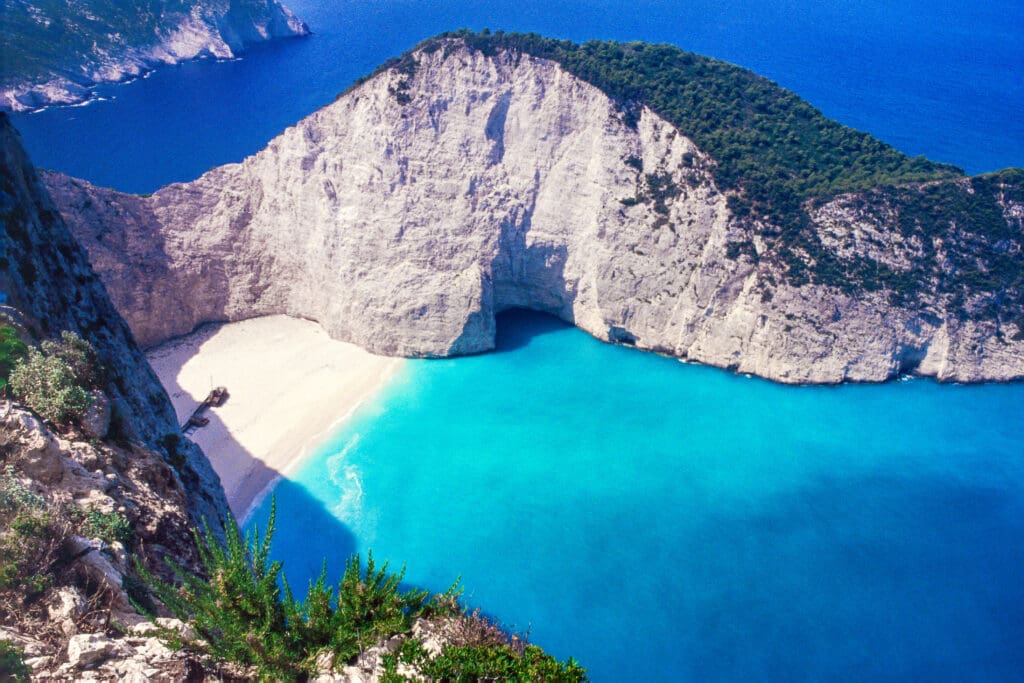
One of the most touristed Greek Islands, Zakynthos vies with Corfu for the top spot in the Ionian Sea.
Name-dropped by Homer, Zakynthos mixes archeological sites and medieval elements. But the best landmarks are its natural marvels.
Greece’s first National Marine Park in 1999, the beautiful Bay of Laganas is part of Europe’s Natura 2000 network.
The bay and Marathonisi islet protect the nesting grounds of endangered Caretta Caretta, loggerhead sea turtles. Marathonisi is often called “Turtle Island” because the turtles come to its fine white sands to dig their nests.
Zakynthos’ coastline features striking rock formations and sea cliffs. In particular, the Blue Caves are a series of sea caves carved by azure blue waters.
The island’s hottest hot spot is Navagio Beach. Fondly known as Shipwreck Beach due to the rusting ship MV Panagiotis, abandoned in 1980 on this white pebble beach.
Enclosed by high cliffs in a cove accessible only by boat, Navagio Beach is extremely popular for swimming, picnicking, and photo ops. Indeed, some say it’s the number one most photographed beach in all of Greece.
Tips to Visit Zakynthos
Due to Zakynthos International Airport “Dionysios Solomos” (ZTH) and ferry service, Zakynthos Island is easily accessible.
The most popular attractions, nevertheless, require some advance planning.
In the Bay of Laganas, the small island of Marathonisi requires a boat to visit. Then, only a fraction of the small island beach is open.
Because its white sands are protected breeding grounds for loggerhead sea turtles.
Furthermore, boat traffic can negatively affect the endangered Caretta Caretta, whose sightings are never guaranteed.
Alternatively, see and learn more at the Zakynthos Sea Turtle Rescue Center and Information Center on Gerakas Beach.
In any case, to reduce the impact on turtles and other marine life, please read and follow these guidelines from the Mediterranean Marine Life Center.
Navagio Beach also requires a boat to visit. The beach has, at times, been restricted or limited due to landside concerns, such as in 2018 and again in 2023.
By sea, smaller excursion boats can access the Blue Caves in good weather and maritime conditions. Larger boats must remain outside the caves.
These landmark locations are very popular in the summer months. So the best time to visit is as early as possible in the morning.
Navagio Beach (Shipwreck Beach) and the Blue Caves combine well on a boat excursion with a professional captain.
Check the best tour options and boat excursions.
On foot, the Blue Caves are accessible via a staircase by the Potamitis Windmills and Potamitis Brothers Restaurant.
The staircase zig-zags down the steep cliffside to the Blue Caves.
Famous Landmarks in Greece: North Aegean Sea
Chios
The birthplace of Homer, Chios offers Byzantine churches, a Genoese castle, lively towns, and lovely beaches.
Yet what most distinguishes Chios is its exclusive cultural landmark of mastic agriculture and Mastic Villages.
Mastic Villages and Sfgraffito
A natural resin from trees, mastic is grown, harvested, and produced by hand only on Chios. Mastic is a Greek Protected Domaine of Origin (PDO) crop.
Mastic cultivation is part of the UNESCO Intangible Cultural Heritage of Greece.
The translucent resin droplets are used in mastic gum, oil, powder, mastiha ouzo, mastiha liqueur, and much more.
Twenty-four villages comprise the landmark Mastic Villages, the Mastichochoria, in southern Chios.
Pyrgi is the largest Mastic Village, distinctive for its decorative sgraffito facades. The sgraffito painting technique layers tinted plaster to create ornamental designs.
Fortified gates, archways, alleys, and stone architecture amplify a romantic medieval mood in the Mastichochoria.
Nea Moni
Additionally, Chios is home to Nea Moni, an 11th-century Byzantine monastery and UNESCO World Heritage Site.
Imperial patronage endowed the monastic complex with marble, mosaics, and other “indisputable masterpieces” from “the second golden age of Byzantine art.”
Tips to Visit Chios
Chios Airport “Omiros” (JKH) serves flights from Athens and Thessaloniki regularly, other destinations in season.
Ferries run between Piraeus, Lesbos, and Thessaloniki, as well as Cesme, Türkiye.
A quick and easy day trip from Chios is Oinousses. Part of EU’s Natura 2000 Network, this group of nine small islands and islets are serene hidden gems.
Sculpted by Chios’ award-winning artist Mary Papaconstantinou, a bronze mermaid perches on a rock in the harbor, greeting visitors since 1986.
Take a look at the best tour options.
Famous Landmarks in Greece: Peloponnese
Corinth Canal
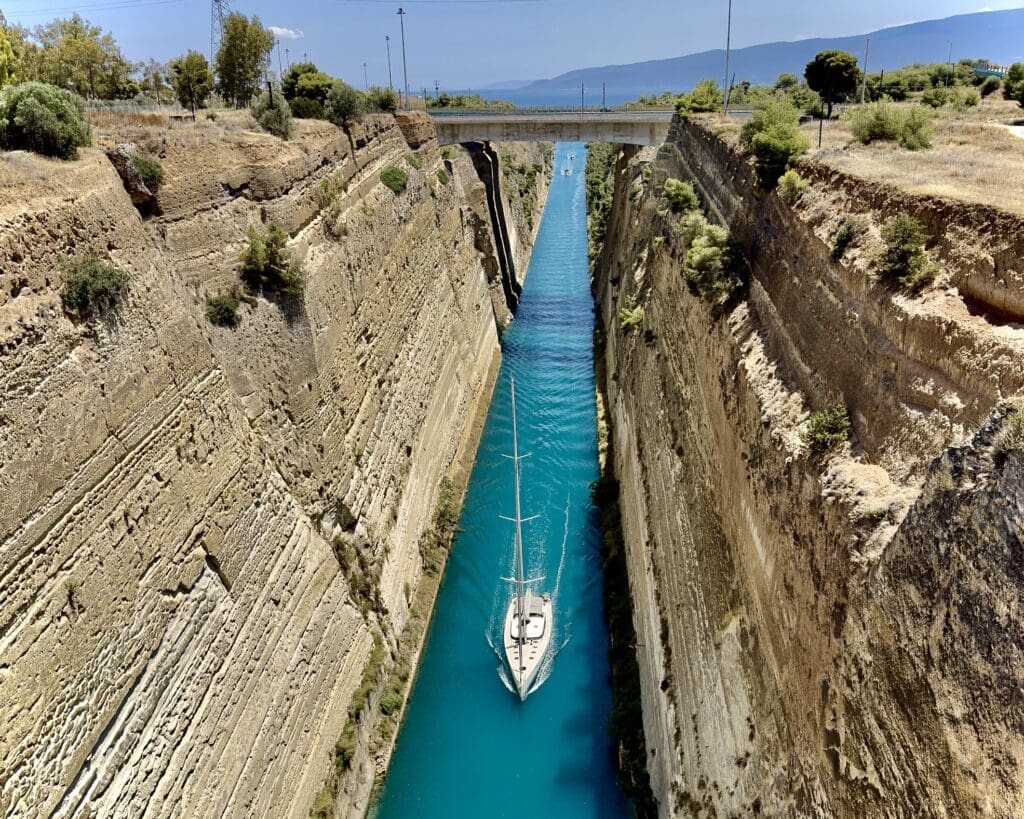
Long and narrow, the Corinth Canal unites the Region of Peloponnese and mainland Greece.
Envisioned and attempted since antiquity, the Canal of Corinth is not one of Greece’s ancient monuments.
Surprisingly, the canal is a 19th-century project. Groundbreaking began in 1881, and the canal opened in 1893.
The Corinthian Canal proceeds in a single straight line for about 4 miles (6.4 km) between the Gulf of Corinth in the Ionian Sea and the Saronic Gulf in the Aegean Sea.
Towering limestone walls emphasize the canal’s narrow width, less than 81 feet (24.6 m) at sea level.
The dimensions limit the types and size of ship traffic, of course, so you won’t see the big commercial ships as on the Suez Canal or Panama Canal.
Besides watching sailboats, yachts, and tourist boats sail through, people cheer to watch adventurers bungee jump from the bridge with the official outfitter, Zulu Bungy.
Welcoming you to Mythical Peloponnese, the Corinth Canal Tourist Information Center highlights the region’s considerable landmarks and major attractions.
Ancient Corinth
Through the ages, the city-state of Ancient Corinth exerted might, wealth, and influence far beyond its borders.
With two harbors, one on the Corinthian Gulf and another on the Saronic Gulf, and a formidable fortified acropolis, Ancient Corintha remained viable and valuable for millenia.
Ancient ruins include the Sanctuary of Demeter and Kore, Peirene Fountain, Roman Odeon, and portions of the Long Walls leading to Lechaeum, the primary port.
Two monumental landmarks emphatically convey the power of Ancient Corinthia:
Firstly, the Temple of Apollo in the Agora of Corinth dates from the mid-6th century BC. Seven of the original 42 Doric columns stand tall on this Archaic Greek temple.
Secondly, the Acropolis of Acrocorinth dominates the Isthmus of Corinth. Beginning late 7th century or early 6th century BC, first Greeks, then Romans, Crusaders, Venetians, and Ottomans continually strengthened and expanded Acrocorinth
With its prime position on a high rocky hill and its freshwater spring, the citadel continues to demand respect today.
Famous Landmarks in Greece: South Aegean Sea
Santorini
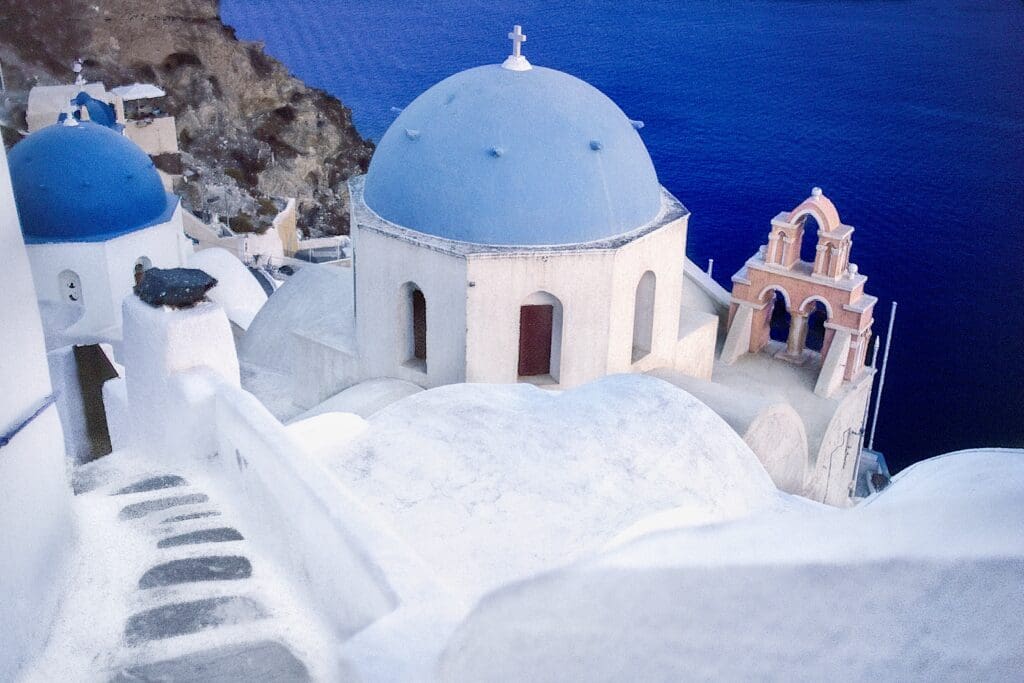
Bright white cubes and bold blue domes define the Cyclades, nowhere more astonishing than Santorini.
Sailing into the caldera, Santorini’s volcanic crater is one of the world’s great arrival experiences.
Santorini Island (also known as Thira, Thera, and Fira) is itself a geological landmark formed by volcanic eruption.
Against the sapphire South Aegean Sea, the contrast of dramatic landscape and brilliant colors astonish and amaze.
Santorini’s breathtaking sunsets, black sand beaches, luxurious lifestyle, and endless photo ops are irresistible.
Regrettably, it must be said that photo ops too often intrude on the roofs of private homes and blue domes of churches.
Despite these understandable allures, Santorini boasts one especially important ancient landmark to visit: Minoan Akrotiri.
Destroyed in a volcanic eruption circa 17th century BC, Akrotiri of Thera links to the Bronze Age Minoan civilization so well developed on Crete.
Akrotiri was a sophisticated city with multi-story architecture, paved streets, and plumbing. Elaborate frescoes and elegant furnishings decorated the homes.
In a similar fashion to Pompeii in Italy, volcanic ash preserved the furniture outlines and also protected the ornate paintings.
Little Legend of Santorini
Various traditions deem Santorini to be a leading candidate for the lost island of Atlantis and Akrotiri as the lost city of Atlanteans.
Was submerged Atlantis either actual history, historical fiction, or mythological invention?
Well, come visit prehistoric Akrotiri and decide for yourself.
Tips to Visit Akrotiri
Given that a modern climate-controlled shelter envelops the site, which is fully accessible to all, Akrotiri is pleasant to visit any time.
Akrotiri is compelling, too, not only for the ruins but also for its legends and real stories.
Access the best tour options.
Mykonos
The trend of Mykonos as a glitterati magnet is nothing new. Because the VIP scene on this Cycladic Island goes back to the 1960s.
First came the artists, the bohemians, and the romantic travelers. Then came the celebrities, the jetsetters, and their entourages. The paparazzi straightway followed the stars.
Amidst swanky beach clubs, stylish nightlife, and the best luxury hotels, its most famous landmark has humble, hard-working origins:
Stout and sturdy Mykonos windmills once powered the island from the 16th century to the 19th century. The windmills captured the Meltemi winds blowing from the North.
Today, these white-washed Venetian-built windmills still dot the island. Many are restored, and some are renovated for vacation rentals.
Arrayed in a tidy line in Mykonos Town, the much-photographed Kato Mili windmills are quintessential Mykonos landmarks.
Little Venice is another Mykonos landmark. These picturesque houses with cute wooden balconies cluster on the Aegean’s edge.
Rhodes
Medieval City of Rhodes
Presiding over the Dodecanese Islands, Rhodes plays a starring role in medieval history and contemporary tourism.
For over 200 years, from 1309 to 1522, Rhodes was a Crusader stronghold and headquarters for the Order of Knights of the Hospital of Saint John of Jerusalem.
The Knights Hospitaller fashioned Rhodes, a UNESCO World Heritage Centre, in Gothic glory.
The ancient citadel city withstood earthquakes and onslaughts, shielded by a 2.4 mile (4 km) long wall, stalwart ramparts, and medieval know-how.
But at last, following a long siege by Suleiman the Magnificent, the Knights surrendered in 1522 and departed Rhodes in 1523.
UNESCO notes that “the chain of history was not broken in 1523 but rather continued up to 1912.”
This unbroken chain makes medieval Rhodes one of the most fascinating historical sites.
Palace of the Grand Master of the Knights of Rhodes
“One of the most beautiful urban ensembles of the Gothic period,” to quote UNESCO, the Palace of the Grand Master of the Knights of Rhodes astounds in scale and style.
Simply put, the Grand Master Palace is among the most impressive medieval landmarks anywhere.
From 7th-century Byzantine fortress to 14th-century Gothic grandeur to 20th-century Italian restoration, the Kastello continues to be relevant in 21st-century events.
Little Legend of Rhodes
“One of the 7 Wonders of the Ancient World Becomes the No. 1 Wonder of the Modern Screen” declares the trailer for a 1960s scandalous (and fabulous!) film by Italian director Sergio Leone.
Yes, the Colossus of Rhodes was one of the real Seven Wonders of the Ancient World.
Similar to the golden statue of goddess Athena on the Acropolis of Athens, this gigantic bronze statue of Helios glimmered from Rhodes far across the sea.
Ancient accounts agree that Chares of Lindos was the sculptor. But its exact location in Rhodes’ harbor, construction methods, and height description differ in ancient accounts.
Nonetheless, consensus holds the Colossus was about 105 feet (32 m).
During the 3rd century BC, the Colossus inspired awe and wonder throughout the ancient world. Until it fell over in an earthquake.
Tips to Visit Rhodes
With Rhodes a top tourist destination, even in shoulder season and especially in summer, timing matters to visit the Grand Masters Palace, its top attraction.
The best time to go is either at opening hour or in late afternoon. Correspondingly, a stroll along the Street of the Knights satisfies the senses. Also, it’s a fabulous photo op when empty.
Then, if schedule permits, take a short walk or long stroll along the castle walls. Bring water, a hat, sunglasses, and sunscreen.
Lastly, consider a professional guided tour to understand Rhodes’ complex history and equally complex architecture.
View the best tour options.
Famous Landmarks in Greece: Thessaly
Meteora
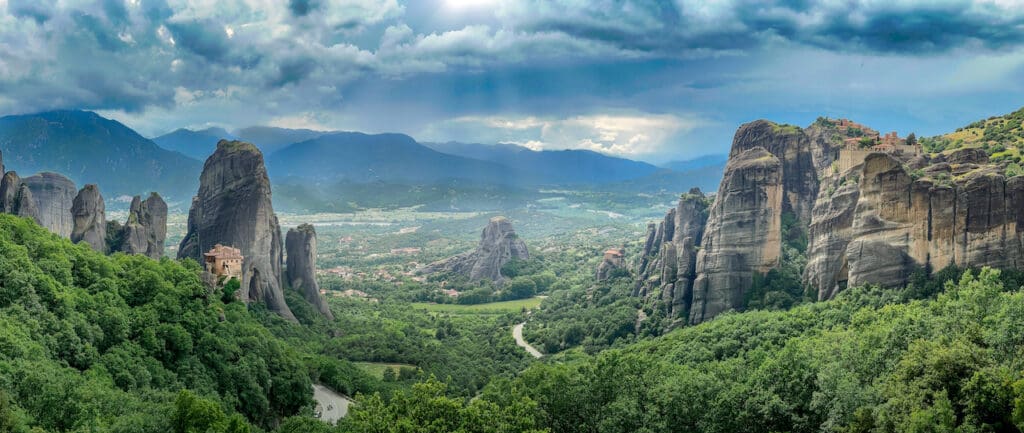
Above Thessaly’s golden fields and green mountains, soaring sandstone pillars rise in sheer splendor against the sky.
Atop these individual towering peaks, monumental faith built the monasteries of Meteora, a UNESCO World Heritage Centre.
In the 11th century AD, hermits seeking solitude first scaled these steep rock formations.
Over time, hauling up stone after stone, the monks built by hand a total of 24 monasteries atop 24 peaks.
Today, six remain as living monasteries, inhabited and active.
These six Meteora monasteries differ in accessibility for present-day visitors:
- With 300 steps each, the Holy Monasteries of Great Meteoron and the Holy Trinity are the longest climb up and down.
- The Holy Monasteries of Rousanou, Saint Nicolaos Anapfasas, and Varlaam each have approximately 140 steps.
- The Holy Monastery of Saint Stefanos has the easiest accessibility, thanks to a small bridge instead of steps.
Oh yes, and Saint Stefanos is a thriving convent.
In 1961, a small group of Orthodox nuns petitioned for permission to reside in and restore the 15th-century monastery.
Today, Saint Stefanos’ religious community continues to grow, attracting women of all ages to godly service.
Tips to Visit Meterora
Whether you arrive by train, bus, or car – which you can certainly do on a day trip from Athens or Thessaloniki – a guided tour is the best way to visit Meteora.
The access road up and down to the monasteries is crowded with buses, bicyclists, and occasionally pedestrians.
So leave the driving to the expert, relax in plush leather seats, and listen to the professional local guide.
Since narration isn’t allowed at the monasteries, your newfound knowledge deepens your experience and appreciation at each monastery.
Explore the best Meteora tour options.
This author and this photographer highly recommend the small group tour experience with the award-winning local agency Visit Meteora.
The town Kalampaka, along with neighboring village Kastraki, is the gateway to visit Meteora.
Kalampaka is worthwhile for an overnight stay, with lively shops, restaurants, and its own special landmark off the beaten path.
Built from the ground up in a central location, The Storyteller Boutique House opened in 2022. This family-owned boutique luxury hotel purposefully designed quality and comfort in every detail:
From free secured guest parking to barrier-free entrances and an elevator. Five serene guest rooms, sleek bathrooms, and thoughtful amenities. As well as fine books curated to different literary and film themes.
Check the best rates for your stay.
Tips to Visit Monasteries
Modest attire is necessary for all visitors; bare shoulders, arms, and legs are not allowed. Each monastery should have inexpensive shawls to purchase at its entrance.
Whether on your own or a guided tour, monastery admission is additional. So, bring cash for the nominal admission fees; 3 Euros at this time of publication.
Famous Landmarks in Greece: Western Greece
Ancient Olympia
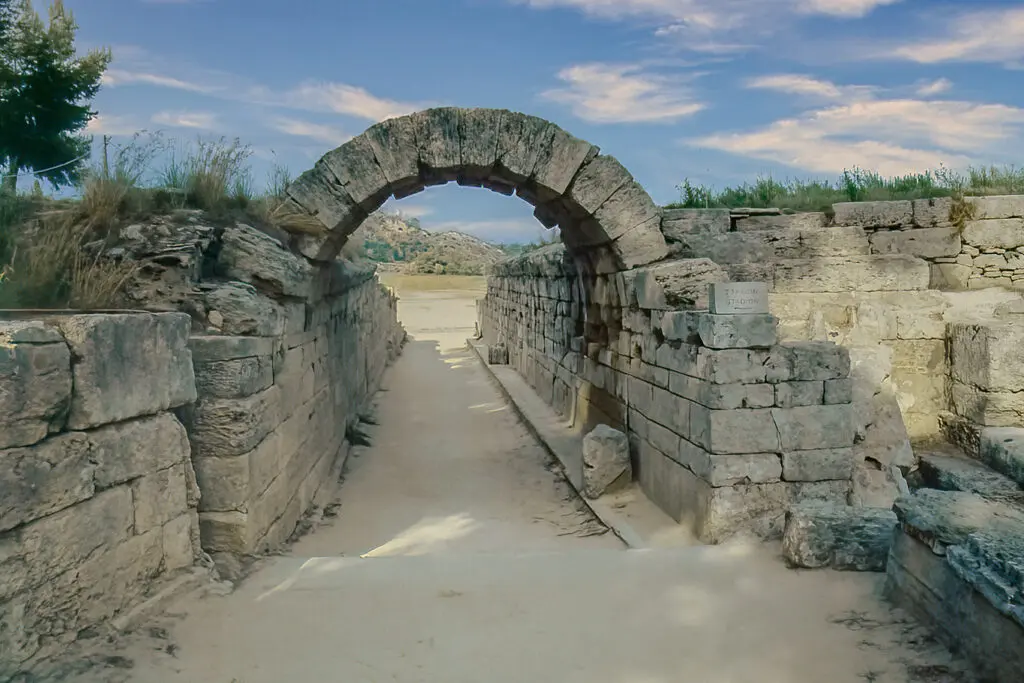
Broadcast to billions around the world, the Modern Olympic Games trace their origins to Ancient Olympia in Olympian Land, the western Peloponnese peninsula.
Ancient Olympia is a UNESCO World Heritage Centre.
Every four years starting circa 776 BC, the Ancient Olympic Games welcomed the Pan-Hellenic world to this verdant valley. Athletes and spectators gathered at the confluence of two rivers.
Thousands of years later, officials continue the rituals by lighting the Olympic flame for all Modern Olympic Games here.
The ancient Greeks celebrated more than athletic prowess and peaceful competition here. The ancient archaeological site of Olympia was a sacred complex, the Sanctuary of Zeus.
As such, the site in ancient times held hundreds of buildings, few more famous than the Temple of Zeus and the Ancient Olympic Stadium.
Temple of Zeus at Olympia
Befitting the King of Greek gods, the Doric Temple of Zeus contained one of the Seven Wonders of the Ancient World:
In the 5th century BC, eminent Phidias of Parthenon fame sculpted a superlative statue of Zeus enthroned in gold and ivory.
Excavations in the 20th century AD uncovered Phidias’ workshop on-site, complete with tools, molds, and material remnants.
Unfortunately, like the goddess Athena on the Acropolis of Athens and the Colossus of Rhodes, this exquisite sculpture from the Temple of Zeus in Ancient Olympia disappeared long ago.
Stadium at Ancient Olympia
One of the best places and most beloved attractions in Olympian Land, the Stadium invites you to follow in the footsteps of ancient athletes:
Firstly, walk through the vaulted tunnel into the stadium. Take your position on the marble starting blocks.
Then, hear the starting whistle silently blow. Then run like the wind down the track.
Finally, cross the finish line in triumph. Raise your arms in a “V” for victory.
Lastly, visualize the enthusiastic crowd leaping to their feet. Their applause is a thunderous barrage.
Now feel the eternal thrill to place the victor’s wreath of olive leaves on your brow.
Famous Landmarks in Greece: Western Macedonia
Lake Orestiada, Kastoria
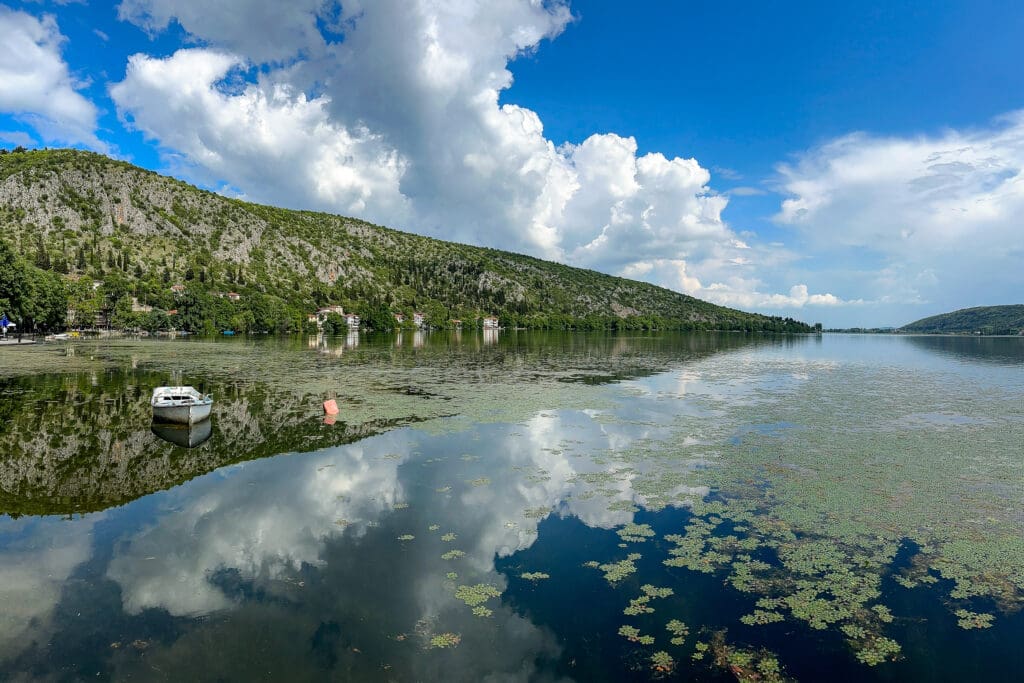
In the Region of Western Macedonia, Lake Orestiada (Orestias) is a Greek National Monument of Natural Beauty.
Rugged mountains frame the tranquil lake, approximately 11 square miles (28 km2). With the historic town Kastoria rising on the promontory, the alpine ambiance enchants.
A long waterfront promenade connects bustling New Town Kastoria with Byzantine Kastoria.
The lakefront is the best area for locals and visitors alike to exercise, see, and be seen at one or another of the numerous waterfront cafes.
Within the EU Natura 2000 network, the lakeshore makes a perfect location for year-round bird watching.
Over 50 species of birds, including threatened and rare species, flock to Lake Orestiades.
Kastoria’s famous mute swans, pelicans, mallard geese, and other water birds remain year-round. More species migrate here to nest and breed during the winter months.
Another lakeside natural attraction is Spileo Drakou, Cave of the Dragon. It’s located on the peninsula, about 1.5 miles (2.5 km) beyond Kastoria Old Town.
Significantly large, the Dragon’s Cave has underground freshwater lakes, the only ones in Greece; bridges, halls, tunnels, and of course, countless stalactites and stalagmites.
Tips to Visit Lake Orestiada, Kastoria
The driving distance between Athens International Airport “Eleftherios Venezilos” (ATH) and Kastoria is about 370 miles (595 km).
Kastoria National Airport “Aristotelis” (KSO) is a small local airport, busiest in peak season.
To clarify, the peak season here in Kastoria is the winter months. When snow falls on the mountains, Mount Visti ski resort opens, and Lake Orestiades occasionally freezes.
In all four seasons, Hotel Doltso is a great option in Kastoria. In the heart of Old Town’s best district, Hotel Doltso has an ideal location with easy access to New Town.
The owners renovated the family’s 19th-century stone manor house into a boutique luxury hotel. The historic building imparts a touch of French flair in its 10 modern rooms and bathrooms.
Check the best rates for your stay.
Famous Landmarks in Greece: Mount Athos
The Holy Mountain and Mount Athos peninsula form an ancient, sacred, and somewhat autonomous region in Central Macedonia’s Chalkidiki peninsula.
Since AD 972, when Byzantine Emperor John I Tzimiskes signed its first constitution, Mount Athos has been the spiritual heart of all Orthodox monastic communities. As well as a UNESCO World Heritage Centre.
Today, more than 1,000 monks from Greece, Serbia, Romania, Bulgaria, and other Orthodox countries live, work, and worship in approximately 20 historic monasteries.
Faith permeates every aspect of life. From religious pursuits; for example, liturgical services and icon painting. To practical vocations; for instance, farms, forestry, kitchens, libraries, etc.
Mount Athos is like nowhere else. So much so that Guinness World Records 1977 records Mount Athos as the world’s most male-dominated society.
Because a law from AD 1066 specifies no females of any age, or boys under 18 without fathers or guardians, may set foot on Mount Athos.
Little Legend of Mount Athos
Tradition tells us that in the 1st century AD, Saint John the Evangelist and the Holy Mother sheltered on Mount Athos during a storm.
From that time on, Athonite traditions, and the 1066 law, state the Virgin Mary would be the only female to set foot on Holy Mountain.
Tips to Visit Mount Athos for Male Pilgrims
As mentioned, only males may visit Mount Athos. All male pilgrims, whether Orthodox or not, must seek a date-specific permit or visa before the pilgrimage.
Age and other regulations apply to receive this written permission. Agioritiki Estia, the official Mount Athos Center, explains the application protocol and process for potential pilgrims.
To make reservations up to six months prior, contact the Pilgrims Bureau Office in Thessaloniki via phone, fax, or email at:
The Mount Athos Pilgrims’ Bureau
Egnatia Street 109
54622 Thessaloniki, Greece
Phone: +(30) 2310-252578
Fax: +(30) 2310-222424
E-mail: athosreservation(at)gmail(dot)com
Tips to Visit Mount Athos for Everyone
For women, couples, families, and everyone else, the best way and, in truth, the only way to see Mount Athos is on a boat tour.
Small cruise ships and private boats with local guides can sail as close as 1,640 feet (500 m) to the Holy Mountain’s shoreline.
Certain cruises and private boats take a sacred approach, a pilgrimage by sea if you will.
Other group tours are secular in nature. Some excursions include a visit to Ammouliani, the inhabited island of Chalkidiki, or other scenic spots.
The best time to plan an Athonite pilgrimage, by land for men or by sea for others, is either mid-April to mid-June or mid-September through October. The weather is comfortable, the crowds are manageable, and the Aegean Sea is calm.
High season, mid-June to mid-September, can be very hot. The Aegean Sea is its calmest, of course, but also crowds are greatest. Winter is cold, wet, and sometimes snowy, although uncrowded. This author, a woman, hears that some monasteries even have heating systems.
Discover the different tour options.
Famous Landmarks in Greece: In Conclusion
Greece is rightly a popular destination for beautiful beaches, sparkling seas, and some of the world’s most famous landmarks.
Greek mythology, rich history, and man-made monuments aside, other important landmarks of natural beauty convey nature’s glory in national parks, forests, mountains, and seas.
Whether you travel across mainland Greece or to the Greek islands, there’s something special to discover everywhere in Greece’s 14 regions.
So come visit Greece and discover these legendary landmarks and legendary stories for yourself.
Map
•••
Check Out More Recommendations
READ: Greek Landmarks Off the Beaten Path to Visit
READ: Vienna in Winter: Best Things to Do During a Magical Season
ALSO READ: Christmas in Lisbon: Best Things to Do in the Festive Season
•••
FAQs
How many famous landmarks in Greece are there?
Between antiquity and today, the number of famous landmarks in Greece keeps increasing.
So, for reliable criteria, let’s look at the number of UNESCO World Heritage Centres.
At the time of publication, Greece has 19 UNESCO World Heritage Registered List.
In 1987, UNESCO registered the first landmark in Greece: the Acropolis of Athens
.In 2023, UNESCO awarded World Heritage Site status to the newest addition: the Zagori Cultural Landscape in Epirus.
Greece presently has 13 landmarks on the UNESCO Tentative Lists under consideration for the Registered List.
Additionally, Greece also has 3 UNESCO World Biosphere Reserves.
Finally, Greece has one entry in the Memory of the World: the Derveni Papyrus.
What’s the most visited island in Greece?
The Cycladic Islands in the South Aegean Sea are the most well-known and popular Greek Islands.
Greece’s most visited island is Santorini, followed by Mykonos.
What’s the most visited landmark in Greece?
The most famous and most visited landmark on the Acropolis is, of course, the Parthenon.
•••
GET: Now that you’ve heard the story of the most famous landmarks in Greece, get your exclusive free guide to tell your own story easily.
•••
All opinions expressed are Spotlight Sojourns’ own.
When you book or make purchases through some links, Spotlight Sojourns may earn a small commission at no cost to you. Thank you for using our links which support original writing and original photography for you.
